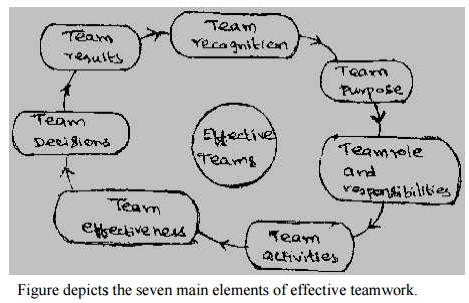Chapter: Mechanical : Total Quality Management (TQM) : Principles
Teams
TEAMS

Employee involvement is optimized
by the use of teams.
├ś A team
is defined as a group of people working together to achieve common objectives
or
goals.
├ś Teamwork is the
cumulative actions of the team during which each member of the team subordinates
his individual interests and opinions to fulfill the objectives or goals of the
group.
WHY TEAMS
WORK
1.
Many heads are more knowledgeable than one.
2.
The whole is greater than the sum of its members.
3.
Team members develop a rapport which each other.
4.
Teams provide the vehicle for improved
communication.
TYPES OF
TEAMS
1.
Process improvement team.
2.
Cross ŌĆō
functional team.
3.
Natural work teams.
4.
Self ŌĆō Directed
/ Self ŌĆō Managed
work teams.
CHARACTERISTICS OF
SUCCESSFUL TEAMS :
1. Sponsor
2. Team Charter
3. Team Composition
4. Training
5. Ground Rules
6. Clear Objectives
7. Accountability
8.Well-Defined decision procedure
9. Resources
10. Trust
11.Effective Problem Solving
12. Open Communication
13. Appropriate Leadership
14. Balanced Participation
15. Cohesiveness
The
effective team should have certain characteristics. These are :
1. Sponsor :
In
order to have effective liason with the quality council, there should be a
sponsor. The sponsor is a person from the quality council, he is
to provide support to the organization.
2. Team
Charter : A team charter is a document that
defines the teamŌĆÖs mission, boundaries, the background
of the problem, the teamŌĆÖs authority and duties, and resources. It also
identifies the
members
and their assigned roles ŌĆō leader, recorder, time keeper
and facilitator.
3. Team Composition : The size
of the team should not exceed ten members except in the case of natural
work teams or self-directed teams. Teams should be diversed by having members
with different skills, perspective and potential. Wherever needed, the internal
and external customers and suppliers should be included as a team member.
4. Training
: The team members should be trained in the problem-solving
techniques, team dynamics and communication skills.
5. Ground
Rules : The team should have separate rules of operation
and conduct. Ground rules should be discussed with the members,
whenever needed it should be reviewed and revised.
6. Clear
Objectives: The objective of the team should be stated
clearly. Without the clear objective, the team functions is not
to be effective.
7. Accountability:
The
team performance is accountable. Periodic status report of the team should be
given to the quality council. The team should review its performance to
determine possible team process weaknesses and make improvements.
8. Well-defined
Decision Procedures: The decision should be made clearly at the
right time by the team.
9. Resources:
The
adequate information should be given to the team wherever needed. The team
cannot be expected to perform successfully without the necessary tools.
10.Trust : Management
must trust the team to perform the task effectively. There must also be trust
among the members and a belief in each other.
11.Effective
Problem-Solving : Problem-solving methods are used to make the
effective decision.
12.
Open Communication : Open
communication should be encouraged i.e., everyone feels free to speak
in the team whatever they are thinking, without any interruptions.
13.
Appropriate Leadership: Leadership
is important in all the team. Leader is a person who leads the
team, motivates the team and guides the team in a proper direction.
14.
Balanced Participation : Everyone
in a team should be involved in the teamŌĆÖs activities by voicing
their opinions, lending their knowledge and encouraging other members to take
part.
15.Cohesiveness:
Members
should be comfortable working with each other and act as a single unit, not
as individuals or subgroups.
ELEMENTS
OF EFFECTIVE TEAM WORK
Main elements
of effective teamwork are as follows:
1. Purpose
2. Role and
responsibilities
3. Activities
4. Effectiveness
6. Results,
and
7. Recognition.

Figure
depicts the seven main elements of effective teamwork .
(i)
STAGES OF TEAM DEVEL OPMENT
Each term takes sometime to start functioning
effectively towards problem solving. Each team goes through six distinct stage
s in its development. These are farming, storming, norming, performing
maintenance and evaaluating.
1. Farming stage : When a
team is created, it consist of group of individuals and team work does not
exist
at this stage. TeamŌĆÖs purpo se, membersŌĆÖ roles, acceptance of roles, authority
and process of
functioning
are learnt in the form ation process.
2. Storming
stage : Initial agree ments and role allocations are
challenged and re-established at this stage of team development.
At th is stage, hostilities and personal needs often e merge which may be
resolved.
3. Norming
stage : During norming stage of team development, formal
and informal relationships get established
among team member s. Openness and cooperation have been observe d as signs of
teamŌĆÖs
behaviour.
4. Performing stage : At this
stage, the team starts operating in successful manner. Trust, openness, healthy
conflict and decisiveness of a groupŌĆÖs performance can be
reached at this stage.
5. Maintenance stage : Functioning
of team does not deteriorate overtime. At this stage, the performance
of teamwork at the earlier stage will be maintained for some period of time.
6.Evaluating
stage : At this stage, teamŌĆÖs performance is to
be evaluated in view of the set targets.
Both self-evaluation and
management-based evaluation form this stage of team development.
TEAM MEMBER ROLES

TEAM
LEADER
├ś Ensures
the smooth and effective operation of the team.
├ś Facilitates
the team process.
├ś Serves as
a Contact Point.
├ś Organizes
the implementation of changes.
├ś Prepares
the meeting agenda.
FACILITATOR
├ś Supports
the leader.
├ś Focuses
on the team process.
├ś Acts as a
resource to the team.
├ś Provides
feedback to the team.
├ś RECORDER
├ś Documents
the main ideas of the teamŌĆÖs discussion, the issues raise, decisions made,
action items
etc.
├ś Presents
the documents and distributes the MOM.
├ś Participates
as a team member.
TIMEKEEPER
├ś Ensures
that the team maintains the schedule.
├ś Participates
as a team member.
TEAM
MEMBER
├ś Contributes
best, without reservation.
├ś Respects
other peopleŌĆÖs contributions.
├ś Listens
carefully and asks questions.
├ś Works for
consensus on decisions.
├ś Supports
the decision of the team.
├ś Understands
and is committed to the team objectives.
├ś Respects
and is tolerant of individual differences.
├ś Acknowledges
and works through conflict openly.
├ś Carries
out assignments.
DECISION
MAKING METHODS
1.
Non-decision.
2.
Unilateral decision.
3.
Handclasp decision.
4.
Minority-rule decision.
5.
Majority-rule decision.
6.
Consensus.
COMMON
BARRIERS TO TEAM PROGRESS
├ś Insufficient
training.
├ś Incompatible
rewards and compensation.
├ś First-line
supervisor resistance.
├ś Lack of
planning.
├ś Lack of
management support.
├ś Access to
information systems.
├ś Lack of
Union support.
├ś Project
scope too large.
├ś Project
objectives are not significant.
├ś No clear
measures of success.
├ś No time to do improvement work.
Related Topics